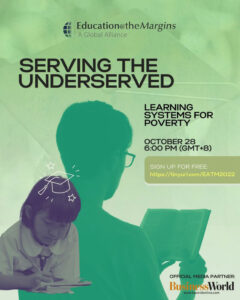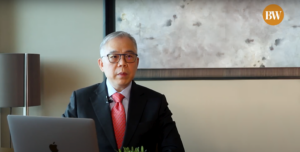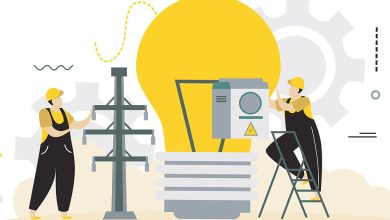Solutions to improve learning systems for poverty discussed at the 2nd annual conference of Education@theMargins: A Global Alliance

Education has been in crisis even before the COVID-19 pandemic disrupted the sector and closed schools. But the global health crisis has worsened the learning situation.
The average global learning poverty rate in low- and middle-income countries was already estimated at 57% pre-pandemic. But due to the school closures, learning poverty in these countries increased to an estimated 70%, according to The State of Global Learning Poverty: 2022 Update. Learning poverty is defined as the inability to read and comprehend a simple text by age 10.
As the world looks to a better normal beyond the recovery from the pandemic, how can the education sector also bounce back and propel the learning of students, especially those at the margins?
This year, Education@theMargins (E@TM): A Global Alliance gathered education, policy reform, and community development experts from various countries in its second annual conference last Oct. 28 to talk about “Serving the Underserved: Learning Systems for Poverty.”
“We realize the problem is huge. And if there’s anything the past two years have taught us, problems know no boundaries, no political or geographical boundaries. Problems are global,” said PHINMA Education President and CEO Chito Salazar. “What vexes me is that while the problems are global and shared, we tend to look at solutions on a local level, on a domestic level, on our own. E@TM is an attempt to reach out, to find other kindred spirits who we can learn from [and] debate [with].”
“As we build our learning systems around low-income students, we’re actually creating a system that will contribute to the success of all other student groups,” said Nigel Cabison, chief analytics officer at PHINMA Education. “This is because the strategies that work for low-income, first-generation students are likely to be successful for the general student population as well. So there’s a lot of work before us, but we can take comfort from the fact that we are not alone in this crusade.”
Inequalities
Students at the margins experience inequalities concerning access, completion, and employability, according to Francis Larios, chief learning officer of PHINMA Education. And these inequalities are not just because of financial concerns, but also of their skills.
“For our students in Indonesia and the Philippines, the first thing is that, ‘Can I get into college? Can I pay for it? And even if I pay for it, do I have the reading and math skills to actually qualify or even make it through?’” Mr. Larios explained, giving an example of inequality in terms of access.
The inequality about completion, meanwhile, concerns the ability to reenroll in the following semesters, as well as the limited resources for first-generation college students in terms of asking for help from their parents or siblings in dealing with difficulties in college life.
Then, if students could finish their education, they might also face inequality in terms of employability, when compared, for instance, to their fellow jobseekers who are affluent and have networks.
“Those are things that challenge us to find ways to ‘game the system’ for our students,” said Mr. Larios.
Educating the family
To revise the problem in education for the generations to come, Dr. Charles Prince, chief higher education officer of Global Education Executives, Inc., believed that the family should also be educated, not just the students.
“We now have to educate the family. Because just educating one person, the child, or the age-relevant individual is no longer part of the system. We now have to educate mom and dad, grandma and grandpa, and uncle and aunt,” he said.
“The family is an economic unit now. It is not just one person to go off to work and bring the money back to the family. It’s everyone. So, now, we have to think about how we, as a university, bring everybody from that family onto campus to learn in a degree program,” he continued.
Noting that education in the 1800s or early 1900s used to be brought to the community and the family, Dr. Prince thus said, “We need to bring the education to them, not have them come to us.”
“We have to go back to a kind of an older system first to hit the reset button to make sure that our education people are trained [and] educated to their appropriate levels, and then we can start thinking about how the teacher can then close the equity gaps between those who are rich and poor,” he said.
Learning outside the classroom
Meanwhile, AfricaX Academy Founder Jessica Rees-Jones highlighted the need to learn beyond the classroom and the role that technology could play in it.
“When we talk about education, I would encourage that there is thinking outside the classroom, learning outside the classroom, that there is a lifelong learning approach from early childhood development through to adult learning, and inside and outside the classroom. And I think that’s where technology comes in,” she said.
“I think that’s going to shift a lot of how to address this. It’s not always about the money. When we say poverty, it can be education-poor; it doesn’t mean financially poor. And I think technology will be the enabler that will allow for a lot of those barriers to be broken down,” she added.
Ms. Rees-Jones also mentioned that technology could enable people to learn and produce content differently.
“You can still deliver quality content and quality learning experience, but you can change the behavior around it,” she said.
Having a growth mindset and a purpose
As the underserved get educated, they must also be nurtured to have a growth mindset and a purpose to achieve their dreams.
“I think the very serious problem of poor children is the lack of inspiration, confidence, and belief that they will be able to overcome. They’re probably just convinced that since their parents and grandparents were poor because of intergenerational poverty, they could no longer rise up from what they have. So there’s a ceiling there that blocks them,” said Dr. Nene Guevara, president of Synergeia Foundation.
Thus, for Synergeia’s part, they give hope and inspiration to children.
“The first thing is to let them stand up, let them dream, and tell and convince them that we’re here, you can become what you want to be, and all the skills will follow,” shared Dr. Guevara.
Meanwhile, Fahad Tanveer, co-founder and chief executive officer of EDKASA, mentioned their belief in the significance of giving young people a purpose.
“When you enter our office, the biggest thing you’ll see in front of you says, ‘The bridge between the world that you have and the world that you want is an education.’ So it’s something that we really believe in,” he shared.
“So, if you really want to achieve anything in your life, education will help you get there,” he added.
Education@theMargins (E@TM): A Global Alliance is an annual conference spearheaded by PHINMA Education.
Spotlight is BusinessWorld’s sponsored section that allows advertisers to amplify their brand and connect with BusinessWorld’s audience by enabling them to publish their stories directly on the BusinessWorld Web site. For more information, send an email to online@bworldonline.com.
Join us on Viber to get more updates from BusinessWorld: https://bit.ly/3hv6bLA.




